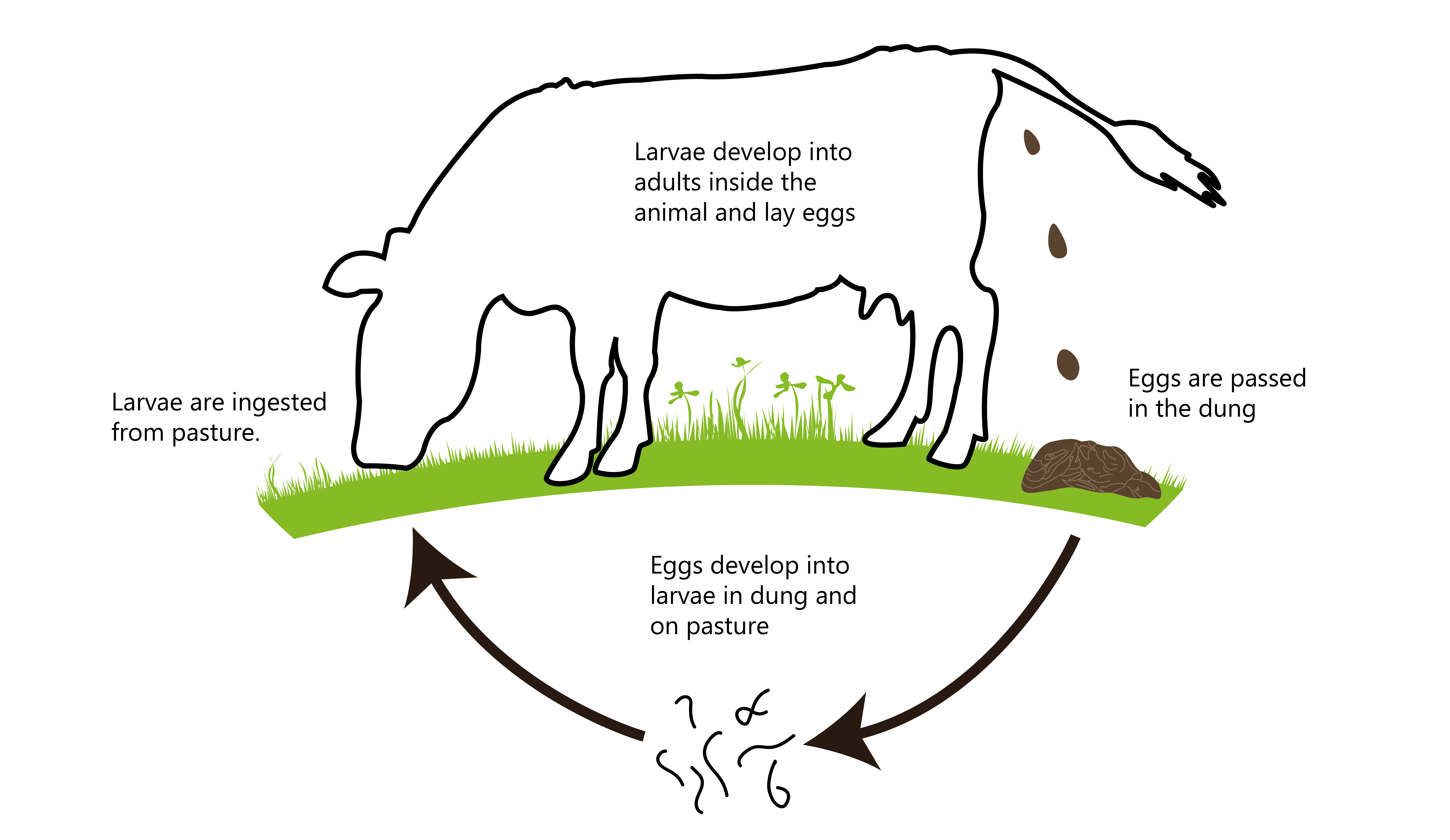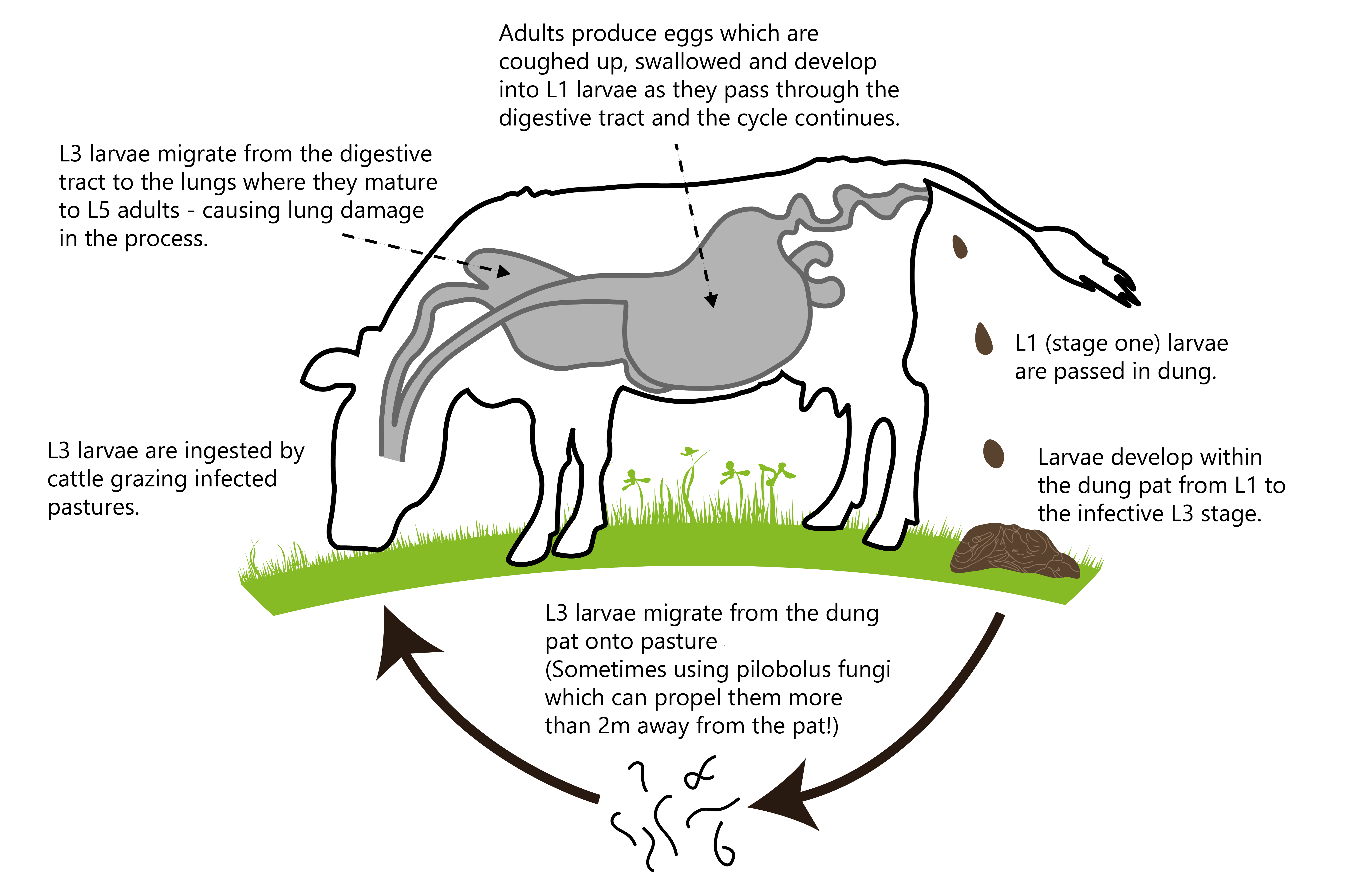Faecal worm egg counts
One of the first steps to understanding control of parasites in our livestock is to understand the lifecycle of the parasites themselves. By understanding these lifecycles, we can better understand how / when we are able to diagnose and treat.
This page focuses solely on parasitic gut / lungworms. There are other parasites that can affect your livestock with a variety of different life cycles.
Gutworm lifecycle

Larvae can remain viable on pasture for over one year and reinfect livestock during the next grazing season. This is where pasture management may play a role.
The complete lifecycle takes about three weeks.
Some gutworms such as Ostertagia in cattle can overwinter in the animal and emerge in spring, causing severe disease.
Lungworm lifecycle

The entire cycle takes approximately 4 weeks.
Why take faecal samples?
- To help diagnose clinical disease associated with gutworms, lungworm and coccidiosis / fluke amongst others. This may be on an individual or group basis.
- Monitoring worm burdens throughout the grazing season to decide whether treatment is necessary. If it is not required, this will save money in both time, labour, and worming product.
- To check efficacy of worming treatments. With recent studies showing increasing resistance to worming products in livestock it may be that efficacy is reduced. If you have wormed your animals, you should check whether it has worked by taking a further sample 7 to 16 days after wormer use (depending on the product used). This is known as a Faecal Egg Count Reduction Test or FECRT.
- By only using worming products when they are required can prevent resistance problems on your farm
Taking samples – for monitoring purposes
Warning: animal faeces can contain zoonotic material including bacteria that may be transmissible to humans. Basic hygiene should be practiced when collecting faeces samples. Gloves must be worn, and children / immunocompromised individuals or pregnant women should avoid collecting samples.
Hands must be thoroughly washed after contact and if storing samples, place them in the farm refrigerator NOT domestic.
Faecal egg counts must not be undertaken in food preparation areas.
- Faecal worm egg counts should start 4-6 weeks post-turnout and will be particular to your farm. For overwintering animals – getting a baseline FWEC in late March would be useful.
- The number of samples you take should be representative of the number in the group. Ideally, a minimum of 10 samples. Make sure, you take samples from EACH management group. What is going on in one field / age group may not be reflective of the rest.
- Samples must be as fresh as possible. Ideally, watch and wait for animals to pass muck (it should be warm) or take samples within 24hr after moving to fresh pasture when you know all the samples will be fresh. Lying animals often pass muck as they stand up.
- You will require about 40g per animal – try to take samples from at least two areas or otherwise scoop up a handful using a glove.
- Expel as much air as possible from the sample pot / glove before you seal it.
- Samples should be taken individually and should not be pooled at the time of collection.
- Samples ideally want to be examined as soon as possible after collection ideally within 48 hours. If unable to do FWEC quickly – store samples in fridge where they can be kept for a few days.
- Samples can be given to your vet or alternatively there are labs where you can send them yourself.
- Most veterinary practices will be able to offer Coccidia counts alongside worm egg counts.
You can examine the samples yourself “DIY testing” or ask your vet practice to do this for you. If you are going to test yourself, I would always advise sending the first couple of samples to your vet or a lab as well to act as quality control – you do not want to get this wrong!
Your vet / SQP will also be able to go through how to do the testing with you.
Other factors should be taken into consideration alongside faecal egg count results when deciding to worm alongside your own attitude to risk! For this reason, we have not given any numbers above which you would decide to treat or not. We would urge you to discuss any findings with your vet / laboratory.
Do the animals look well?
When taking samples, use this as an opportunity to check over the group. Take Body Condition Scores (BCS) from a representative sample of animals, listen for coughs and gauge an approximate percentage of the group with dirty backsides / loose muck. All these findings, alongside the faecal samples, and in discussion with your vet will help determine whether you want to do further sampling and / or treat. Collecting this information alongside your samples along with worming history will help your vet / SQP advise you on the best course of action.
Faecal egg counts do not accurately reflect total worm burden which is why it is important that you discuss any results with your vet / SQP who can take this into account alongside your herd / flock status.
